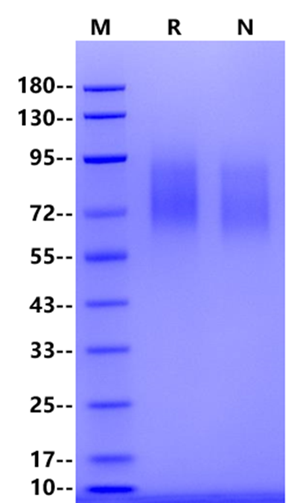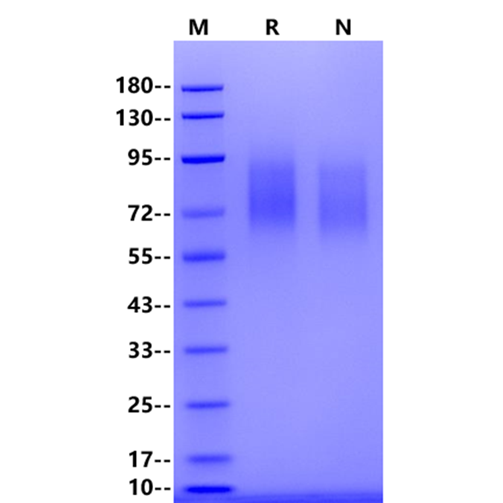Product Details
Product Details
Product Specification
| Species | Cynomolgus |
| Synonyms | CEACAM1, CD66a, BGP, BGP1, BGPI |
| Accession | XP_005589426.2 |
| Amino Acid Sequence | Gln35-Gly428, with C-terminal 8*His QLTIESRPFNVAEGKEVLLLAHNLSQNLIGYNWHKGERVDAKRLIVAYVIETKQTTPGPAHSGREMIYSNASLLIQNVTQNDTGSYTLQVIKGDLVNEEATGQFRVYPELPKPNITINNSNPVEDKDVVTFTCESEAQDTTYLWWVNNQSLPVSSRLQLSNGNKTLTLLSVLRNDTGPYECEIQNPVSANRSDPVTLNVTYGPDTPTISPSDTYYRPGANLSLSCSAASNPPAQYSWLINETFQQSTQELFIPNITVNNSGSYTCHANNSVTGRNRTTVKMIIVSEQSLVVAQPQIKASKTTVTEDKDYVNLTCSTNDTGISISWFFKDQSLPSSERMKLSQDNATLSINPVKREDAGNYSCEVFNLISKNRSDPIVLIVNYNNPAQENSLPAGGGGSHHHHHHHH |
| Expression System | HEK293 |
| Molecular Weight | 65-93kDa |
| Purity | >95% by SDS-PAGE |
| Endotoxin | <0.1EU/μg |
| Conjugation | Unconjugated |
| Tag | His Tag |
| Physical Appearance | Lyophilized Powder |
| Storage Buffer | PBS, pH7.4 |
| Reconstitution | Reconstitute at 0.1-1 mg/ml according to the size in ultrapure water after rapid centrifugation. |
| Stability & Storage | · 12 months from date of receipt, lyophilized powder stored at -20 to -80℃. · 3 months, -20 to -80℃ under sterile conditions after reconstitution. · 1 week, 2 to 8℃ under sterile conditions after reconstitution. · Please avoid repeated freeze-thaw cycles. |
| Reference | 1、Tsugawa N. et al. (2021) CEACAM1 specifically suppresses B cell receptor signaling-mediated activation. Biochem Biophys Res Commun. 535: 99-105. |
Background
Carcinoembryonic antigen-related cell adhesion molecule 1 (CEACAM1) is a type I transmembrane glycoprotein and a member of the CEA family. The extracellular domain of CEACAM1 consists of a membrane-distal immunoglobulin (Ig)V-like N-region and variable numbers of alternating IgC1- and IgC2-like proximal regions. Therefore, this molecule is also classified as a member of the Ig supergene family. Several heterophilic ligands for the N-domain of CEACAM1 have been reported. However, homophilic ligation of the N-domains of CEACAM1 with another N-domain of CEACAM1 is the predominant means of physiologic interaction. CEACAM1 has been reported to be involved in several functions such as tumor growth, angiogenesis, endocrine function and immunology in humans and rodents.
Picture
Picture
SDS-PAGE

2μg (R: reducing conditions, N: non-reducing conditions).


